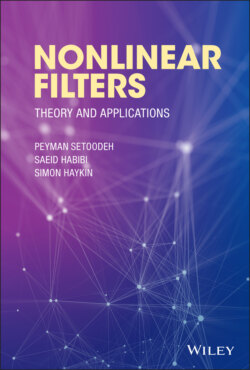Читать книгу Nonlinear Filters - Simon Haykin - Страница 41
4.3 Optimal Nonlinear Filtering
ОглавлениеThe following discrete‐time stochastic state‐space model describes the behavior of a discrete‐time nonlinear system:
(4.3)
(4.4)
where , , and denote the state, the input, and the output vectors, respectively. Compared with the deterministic nonlinear discrete‐time model in (2.78) and (2.79), two additional variables are included in the above stochastic model, which are the process noise, , and the measurement noise, . These two random variables take account of model inaccuracies and other sources of uncertainty. The more accurate the model is, the smaller the contribution of noise terms will be. These two noise sequences are assumed to be white, independent of each other, and independent from the initial state. The probabilistic model of the state evolution in (4.3) is assumed to be a first‐order Markov process, and therefore, can be rewritten as the following state‐transition probability density function (PDF) [46]:
(4.5)
Similarly, the measurement model in (4.4) can be represented by the following PDF:
(4.6)
The input sequence and the available measurement sequence at time instant are denoted by and , respectively. These two sequences form the available information at time , hence the union of these two sets is called the information set, [47].
A filter uses the inputs and available observations up to time instant , to estimate the state at , . In other words, a filter tries to solve an inverse problem to infer the states (cause) from the observations (effect). Due to uncertainties, different values of the state could have led to the obtained measurement sequence, . The Bayesian framework allows us to associate a degree of belief to these possibly valid values of state. The main idea here is to start from an initial density for the state vector, , and recursively calculate the posterior PDF, based on the measurements. This can be done by a filtering algorithm that includes two‐stages of prediction and update [46].
In the prediction stage, the Chapman–Kolmogorov equation can be used to calculate the prediction density, , from , which is provided by the update stage of the previous iteration. Using (4.5), the prediction density can be computed as [46, 47]:
(4.7)
When a new measurement is obtained, the prediction stage is followed by the update stage, where the above prediction density will play the role of the prior. Bayes' rule is used to compute the posterior density of the state as [46, 47]:
(4.8)
where the normalization constant in the denominator is obtained as:
(4.9)
The recursive propagation of the state posterior density according to equations (4.7) and (4.8) provides the basis of the Bayesian solution. Having the posterior, , the optimal state estimate can be obtained based on a specific criterion. Depending on the chosen criterion, different estimators are obtained [46–48]:
Minimum mean‐square error (MMSE) estimator(4.10) This is equivalent to minimizing the trace (sum of the diagonal elements) of the estimation‐error covariance matrix. The MMSE estimate is the conditional mean of :(4.11) where the expectation is taken with respect to the posterior, .
Risk‐sensitive (RS) estimator(4.12) Compared to the MMSE estimator, the RS estimator is less sensitive to uncertainties. In other words, it is a more robust estimator [49].
Maximum a posteriori (MAP) estimator(4.13)
Minimax estimator(4.14) The minimax estimate is the medium of the posterior, . The minimax technique is used to achieve optimal performance under the worst‐case condition [50].
The most probable (MP) estimator(4.15) MP estimate is the mode of the posterior, . For a uniform prior, this estimate will be identical to the maximum likelihood (ML) estimate.(4.16)
In general, there may not exist simple analytic forms for the corresponding PDFs. Without an analytic form, the PDF for a single variable will be equivalent to an infinite‐dimensional vector that must be stored for performing the required computations. In such cases, obtaining the Bayesian solution will be computationally intractable. In other words, the Bayesian solution except for special cases, is a conceptual solution, and generally speaking, it cannot be determined analytically. In many practical situations, we will have to use some sort of approximation, and therefore, settle for a suboptimal Bayesian solution [46]. Different approximation methods lead to different filtering algorithms.
